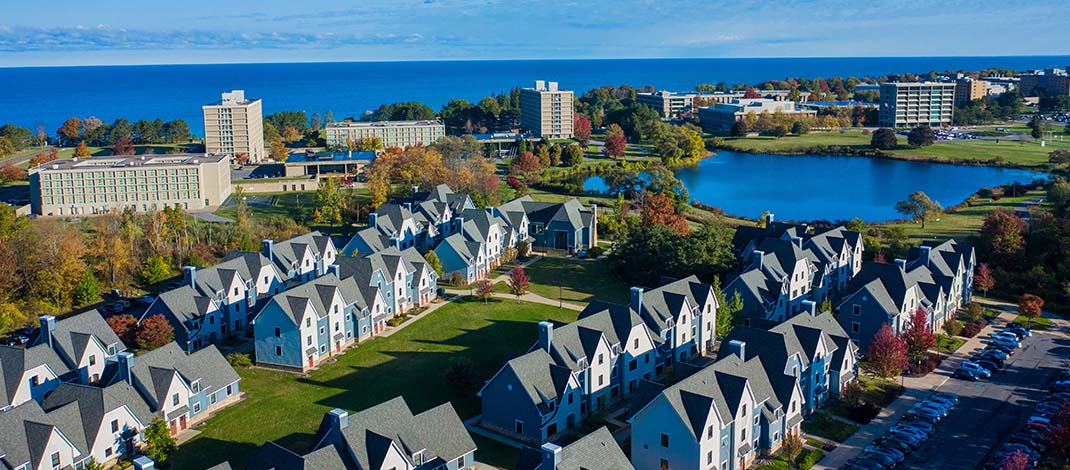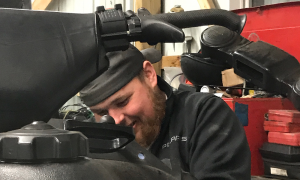By Mary Beth Roach
The impact of the COVID-19 pandemic continues, worsening the decline in enrollment many colleges nationwide have been experiencing.
According to a report from the National Student Clearinghouse Research Center, colleges saw a decrease of 3.2% in undergraduate enrollment last fall, on top of a 3.4% drop the previous academic year, the first fall of the pandemic.
The report also suggested the decline could impact the job market and the economy in the future.
We talked with administration officials from SUNY Oswego, LeMoyne College and Onondaga Community College to see how they are faring. A representative for Syracuse University said the school does not comment on enrollment.
SUNY Oswego
SUNY Oswego has seen a decline since the pandemic hit.
New student enrollment in the fall of 2019, pre-COVID-19, was 2,127; a decline in the 2020-21 academic year 1,897 in the fall of 2020; and 1,742 in the fall of 2021.
Its total student enrollment was 7,832 in the fall of 2019; 7,636 in the fall of 2020; and 7,058 this past fall.
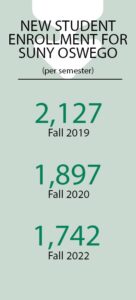 College officials, however, remain optimistic as they are seeing an increase in applications over last year — from 9,138 in 2021 to 10,563 in 2022. It’s starting to improve for the 2021-22 year, according to Mary Toale, officer-in-charge.
College officials, however, remain optimistic as they are seeing an increase in applications over last year — from 9,138 in 2021 to 10,563 in 2022. It’s starting to improve for the 2021-22 year, according to Mary Toale, officer-in-charge.
The college is seeing a 26% increase in applications over last year at this point in time, with more coming from Oswego and the contiguous counties, according to Wayne Westervelt, chief communication officer for the college.
“While I don’t think we’ll get back to where we were three years ago, we’re beginning the process of really coming back strong with our traditional-age population,” said Scott Furlong, provost and academic vice president for academic affairs.
Officials noted that they have seen an increase in the college’s online enrollment and in its graduate programs over the past year or two.
Its international enrollment is increasing, too, as travel becomes easier and its Syracuse campus at Clinton Square has seen some growth.
With the graduate students, Furlong said, “I think what we’re seeing economically is that more and more the master’s degree is becoming the degree of choice for many businesses.”
There are a lot of variables, some specific to COVID-19, that affect enrollment, according to Furlong.
Demographics in the Northeast and the Midwest have been changing — something that many in the field have been watching for a while, Furlong said.
While COVID-19 may be a catalyst, competition is fierce and some are questioning the value of a college degree, he added. Furthermore, some students who haven’t been able to get that full on-campus college experience because of the pandemic are doing a cost-benefit analysis. The pandemic has affected many families’ incomes and their ability to afford to send their child to college.
Colleges too have had issues with recruitment. Furlong noted some obstacles, especially in the pandemic’s first year, which plagued recruitment efforts, including access to applications; the inability of high school guidance counselors to meet with students and of colleges to meet with guidance counselors; and the lack of campus tours.
SUNY Oswego, like all colleges, has had to adapt to the changing landscape. They’ve created a bigger online presence.
“We’re seeing more demand and we’re supplying some more degrees in an online environment than we would have done five or 10 years ago,” Furlong said. “We’ve been watching the trends even before the pandemic and wanting to come up with other ways. We think we have something to offer in the online environment that could provide additional access to our students.”
Other programs have been added over the last few years, a recent one being the integrated professional studies program. The music program offers an audio recording degree; several minors have been added to the business program and the $85-million renovation project at Hewitt Hall continues with the goal, said Westervelt, of creating a premier broadcasting and mass communication facility.
The college’s mental health counseling program has dramatically increased during the pandemic, as students seek credentials and further education in that field, Toale said.
On the grad level, a biomedical and health informatics programs were added in 2016.
The college, like many of its counterparts, talks with businesses to determine what they need in prospective employees. For example, a partnership with SRC, Inc. began in 2014, in which SUNY Oswego offers an online MBA program to employees, “helping propel them in their careers,” Westervelt said.
People are retooling, as they look at how they can further their development, Toale said. “Being able to expand those opportunities, I think that draws people in,” she added.
Furlong added that data has indicated that students going into the workforce these days are going to have several different careers, not just jobs, throughout the lifetime.
“We think what our degree provides is not only an in-depth learning environment of a discipline or a skill, but the broader ability to think, the ability to evolve, to learn on the spot what they need to and move into other careers or higher levels within their organization,” he said.
LeMoyne College
Because of the unknowns of COVID-19, LeMoyne took a conservative approach to budgeting, said Tim Lee, Ph.D., vice president for enrollment management. And it looked to bring in a smaller class.
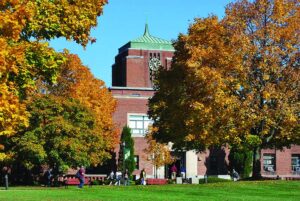 The school’s typical goal is 625 and it had more than 650 for the fall of 2020. For the fall of 2021 class, it budgeted for 600 and came in at 625. It hit both its overall enrollment budget both in undergraduate and graduate, Lee said.
The school’s typical goal is 625 and it had more than 650 for the fall of 2020. For the fall of 2021 class, it budgeted for 600 and came in at 625. It hit both its overall enrollment budget both in undergraduate and graduate, Lee said.
The current academic year exceeded the enrollment budget by about 25 students and the fall of 2020 class between 25 to 30 students.
“Ironically, we hit the usual goal in a year that we budgeted for and expected a smaller class,” Lee said.
“We hit our overall enrollment budget both in undergraduate and graduate. I feel fortunate that LeMoyne was able to exceed its first-year goals two years in a row during COVID-19.”
Lee provided some additional statistics. The college’s 10-year average for first-to-second year retention is more than 85%. For the fall 2020 entering class, which entered six months into the pandemic, retention dropped to just less than 82%.
Typically, first-year class retention from fall (their first semester) to spring (their second semester) is about 94%. Last year, LeMoyne dipped to 90%, but for the incoming 2021 cohort, it’s above that number.
“I think a lot of students enrolled in that first year didn’t have a traditional college experience,” he explained, suggesting for those who felt that their expectations weren’t being met, they opted to take some time off, do something else and perhaps re-enroll when things returned to normal.
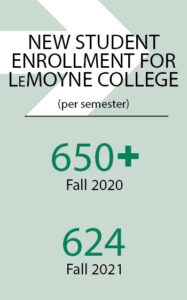
LeMoyne has been able to buck this trend with some advance planning, Lee said.
“I think we’re pretty intentional with our plans. We had some plans in place. We were able to pivot really quickly and move a lot of things online,” he explained.
Recruitment is key for enrollment, but when COVID-19 first hit, it was springtime, when the colleges first interact with high school juniors, he pointed out.
“We really lost two full recruiting cycles,” Lee said.
So, they set up a lot of Zoom meetings and increased their digital marketing and outreach.
Another big shift was to move from being partially to fully test-optional.
This means that a college would not require the ACTs or SATs, but the student could submit their scores if they wanted. For the most part, LeMoyne had been test optional for the past seven or eight years, but they still had a few programs that required the scores. In addition, LeMoyne told high school guidance counselors that they no longer needed to write lengthy recommendations on students, that a couple of sentences would be sufficient. If a student was borderline, the college would follow up with a phone call.
“I think eliminating some of those barriers that were typical requirements in the past allowed us to interact with more counselors and to complete more applications than usual. I think students and counselors appreciated that,” Lee said.
While LeMoyne may not be experiencing the same enrollment issues the national report highlighted, Lee agrees with its findings overall.
Current high school juniors have not had the traditional high school experience and now they’re seeing that their college experience might not be either, Lee said. They may choose to put off their college plans until things return to normal.
“I think some families are re-evaluating college and what it means. Do they want the full college experience or are they going to take the quickest and shortest route to get to a certain level of licensures or job level?” he said.
Some students, he surmised, will opt for a job where they’re making decent money for their age. If their employees offer educational benefits, they might return to school part-time. Maybe it’ll take a little bit longer to get a 2- or 4-year degree,” he said.
Onondaga Community College
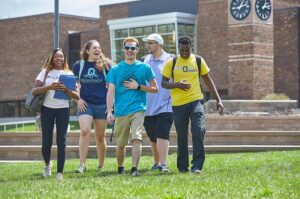 The pandemic has hit Onondaga Community College extremely hard, with their enrollment figures showing an approximate 10% decrease each year of COVID-19, said Roger Mirabito, executive director of communications at the community college.
The pandemic has hit Onondaga Community College extremely hard, with their enrollment figures showing an approximate 10% decrease each year of COVID-19, said Roger Mirabito, executive director of communications at the community college.
A major factor in that decline is the difference in the makeup of the student body at OCC as compared with that of four-year colleges.
“Eighty percent of our students work 30 hours a week or more, and they work the types of jobs that were the most severely impacted by COVID-19,” Mirabito explained.
Many of these students were already struggling financially, and with the pandemic, “they had the rug pulled out from under them,” he added.
“Coming back to school wasn’t as strong an option for them as maybe it had been a year before. They needed to find something to do, work and survive.”
For the fall of 2021, OCC’s enrollment was at 7,687. Compare this to its peak, when in the fall of 2010, it was 13,051. Enrollment at community colleges, he said, has been decreasing, but the pandemic has accelerated that decline, Mirabito said.
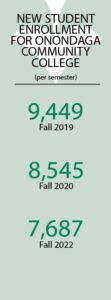
However, there are other reasons driving the COVID-19-related decrease, he pointed out.
When colleges went remote, some students had problems with accessing a computer, like if they lived in an apartment with several other individuals and the housemates shared one computer. Getting time on the computer and finding a quiet space was challenging. Some students didn’t have access to a computer at all or to WiFi hot spots and some need the in-person learning.
Recruitment efforts have been hampered, too, as it’s been challenging to get into high schools and spend time with prospective college students.
“There’s no question it’s had an impact on enrollment,” Mirabito said.
“Who wants to pay thousands of dollars to go to school and wind up sitting in front of a computer, unless that’s your choice or your life is such that that’s the only thing that works for you. If that’s the case and you understand that and you can excel in that format. But there’s a lot of people who can’t,” he added.
To assist students, OCC set up the Lazer Response Fund in April of 2020. More than $100,000 was raised from donors throughout the community, alumni and businesses to help students who had critical immediate needs on a case-by-case basis. From that fund, the college has been able to provide them, on a temporary basis, with laptops or access to hot spots if they don’t have internet access at home.
The decrease in enrollment may affect the economic curve for years to come, but OCC has been updating their certificate and degree programs to coincide with the current job market trends, especially those in the region, and to facilitate transfers for those students who wish to continue on to a four-year college.
For example, it has created programs for those wishing to earn a paramedic certificate or paramedic degree, degrees in cybersecurity, laboratory science or automotive technology.
While it’s been an ongoing effort to develop and update these programs, the onset of COVID-19 has made it even more timely and important, Mirabito said.
“We’re just really proud of the fact that we’ve been able to stay on top of what is needed out there and then create that to try to get our students in programs that will either lead them directly to a job or a great transfer opportunity to a four-year school,” he said.

